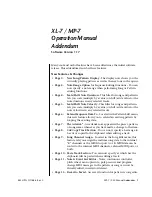
10. Clean and inspect the following parts:
A. Thrust Plate - Check both sides for damage and
flatness.
B. Cylinder Block Assembly - Check surfaces for
wear, scratches and scoring. Also, check the slip-
pers for damage and make sure the pistons are free
in the bores.
C. Ball Bearing - Check for free rotation and notice-
able damage.
D. Pump Shaft - Check for scratches, scoring,
damaged splines and burrs near keyway.
E. Control and Trunnion Shafts - Check for wear,
scratches and burrs.
F. Needle Bearings - Check needle bearings in the
pump housing for free rotation and any noticeable
damage.
G. Swash Plate - Inspect the swash plate for damage
and any noticeable imperfections.
NOTE: Replace any defective part. Remember that the
cylinder block assemblies must be replaced as a com-
plete component, not individual parts. Interchanging
parts between the pump cylinder block assembly and
the motor cylinder block assembly will cause the trans-
mission to malfunction.
11. Lubricate the bearing with transmission oil and press
the bearing onto the shaft. Install the snap ring onto the
shaft. Then slide the shaft and bearing into the pump
housing from the large open side. Install the large snap
ring into the pump housing.
12. Slide the swash plate onto the pump shaft and into
the pump housing. The counterbore side of the swash
plate must face up.
13. Align the holes on both sides of the swash plate with
the holes on both sides of the pump housing. Next, slide
the control and trunnion shafts into the housing and
swash plate. Make sure the control shaft is on the
implement relief side of the housing - see alignment
marks on the shaft and housing. Secure the shafts and
swash plate together with the spring pins.
IMPORTANT: Use only new spring pins when as
sembling the swash plate and shafts - two pins
through the control shaft and one pin through the
trunnion shaft. When installing two pins through the
swash plate and control shaft, drive the first pin
flush with the swash plate and install the other pin
onto the top of the first pin. Drive both pins in until
the top pin is 1/4 inch below the surface of the swash
plate. The pin holding the trunnion shaft must also
be 1/4 inch below the surface of the swash plate.
Make sure the swash plate swings freely; 15
degrees to each side of center.
14. Lubricate the thrust plate with transmission oil. Slide
the thrust plate onto the pump shaft and into the counter-
bore of the swash plate.
15. Lubricate the pump cylinder block parts with oil.
Assemble the cylinder block parts and slide the cylinder
block assembly onto the pump shaft. The cylinder block
must slide onto the splines near center of the shaft.
Assure that the thrust plate remains seated in the
counterbore and that the piston slippers contact the face
of the thrust plate.
16. Push against the back of the cylinder block. A slight
spring pressure assures correct installation of the parts.
17. Assemble the transmission sections if no other
service work is required, refer to "Assembling Transmis-
sion Section".
Figure 26
Figure 27
Repairs
Page 5 - 36
Groundsmaster
®
300 Series
Summary of Contents for Groundsmaster 328-D
Page 2: ......
Page 12: ...Torque Specifications Page 2 4 Rev A Groundsmaster 300 Series ...
Page 44: ...Troubleshooting Page 4 16 Groundsmaster 300 Series ...
Page 45: ...Groundsmaster 300 Series Page 4 17 Troubleshooting ...
Page 171: ...Groundsmaster 300 Series Page 6 25 Testing ...
Page 220: ...Repairs Page 7 24 Groundsmaster 300 Series ...
Page 320: ...Troubleshooting Troubleshooting Page 11 4 Groundsmaster 300 Series ...
Page 348: ...Troubleshooting Troubleshooting Page 12 4 Groundsmaster 300 Series ...
Page 379: ...Troubleshooting Groundsmaster 300 Series Page 13 3 Troubleshooting ...
Page 400: ...This page is blank ...
Page 401: ...This page is blank ...
















































